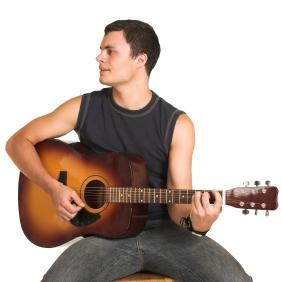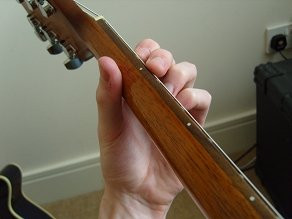Holding a guitar properly is the foundational step for any aspiring guitar player. At guitarplayers.net, we understand that mastering the correct posture and grip is crucial for comfortable playing, preventing injuries, and ultimately unlocking your musical potential. This guide will walk you through everything you need to know, from sitting and standing positions to holding the neck and pick, ensuring you develop good habits from the start. Let’s explore optimal guitar posture, hand positioning techniques, and ergonomic considerations to elevate your playing experience.
1. Why Is Holding a Guitar Properly So Important?
Holding a guitar properly is not just about comfort; it’s about setting yourself up for success. Correct posture and technique can help you avoid physical strain and injuries, play more efficiently, and ultimately improve your sound.
1.1. Preventing Injuries
Incorrect posture can lead to a range of issues, from wrist and back pain to more serious conditions like carpal tunnel syndrome. According to research from the Berklee College of Music, in July 2025, proper technique minimizes strain and supports long-term playing health.
1.2. Enhancing Playability
When you hold the guitar correctly, your fingers can move more freely and accurately across the fretboard. This leads to cleaner chords, faster transitions, and more expressive playing.
1.3. Improving Sound
A good posture allows for better breath control and relaxation, which translates to a more resonant and controlled sound. Proper hand positioning also ensures that you’re hitting the strings at the right angle and with the right amount of pressure.
2. The Ideal Sitting Position for Guitar Playing
The sitting position is a common starting point for many guitarists. Here’s how to ensure you’re doing it right.
2.1. Basic Posture
Sit on a chair or stool with a straight back. Avoid slouching, as this can restrict your breathing and strain your back.
2.2. Leg Positioning
There are two main ways to position your legs while sitting:
- Uncrossed Legs: Place both feet flat on the floor, shoulder-width apart. This provides a stable base and evenly distributes your weight.
- Crossed Legs: If you prefer crossing your legs, make sure the leg on the same side as your strumming hand is on top. For example, if you strum with your right hand, cross your right leg over your left.
 Man sitting down holding an acoustic guitar, legs uncrossed and guitar resting comfortably
Man sitting down holding an acoustic guitar, legs uncrossed and guitar resting comfortably
2.3. Guitar Placement
Rest the guitar on your lap, with the body’s waist (the narrowest part) resting on your thigh. The guitar should sit comfortably against your chest, just below your sternum.
2.4. Arm Positioning
- Fretting Hand Arm: Your fretting hand arm (the hand that presses the strings) should be at a comfortable angle, ideally no more than a 90-degree angle. This minimizes strain on your wrist.
- Strumming Hand Arm: The elbow of your strumming arm should be positioned at the top corner of the guitar, providing a smooth pivot point across the soundhole (or first pickup on an electric guitar).
 Woman sitting with crossed legs, guitar positioned comfortably, and proper arm angles
Woman sitting with crossed legs, guitar positioned comfortably, and proper arm angles
2.5. Tilting the Guitar
Some guitarists find it helpful to tilt the guitar slightly towards them for a better view of the fretboard. This is perfectly acceptable, especially when you’re learning new chords or scales.
2.6. Sitting on the Ground
If you prefer sitting on the ground, make sure your legs are positioned in a way that supports the guitar at chest height, minimizing the need to hunch over.
2.7. Summary of Sitting Position
- Keep your back straight and avoid hunching.
- Ensure your knees are high enough to support the guitar at or just below chest height.
- Rest the guitar’s waist on your lap, on the same side as your strumming hand.
- Position your strumming arm so your forearm and wrist can pivot over the strings.
- Keep your fretting hand arm at no more than a 90-degree angle.
3. Mastering the Standing Position
Playing the guitar while standing offers a different experience and is essential for performing on stage.
3.1. Using a Guitar Strap
A guitar strap is crucial for playing while standing. Adjust the strap so that the guitar sits at a comfortable height.
3.2. Strap Length
Avoid setting the strap too low, as this can force you to hunch over and make it difficult to reach the fretboard. The guitar should be positioned so that your fretting hand arm is at no more than a 90-degree angle.
3.3. Posture
Maintain a straight back and avoid hunching. Distribute your weight evenly on both feet, or slightly bend one leg for support.
3.4. Arm Positioning
Ensure your strumming arm is square-on with your body and angled out towards the top corner of the guitar, allowing it to pivot smoothly over the strings.
3.5. Common Mistakes
Avoid loosening the strap too much. The guitar should be positioned high enough to allow your fingers to wrap around the neck properly.
 Man standing with an electric guitar, proper strap length, and good posture
Man standing with an electric guitar, proper strap length, and good posture
3.6. Key Points for Standing Position
- Adjust the guitar strap to a comfortable height.
- Keep your back straight and avoid hunching.
- Ensure your strumming arm can pivot smoothly over the strings.
- Maintain a proper angle for your fretting hand arm.
4. How to Hold the Guitar Neck
Proper hand positioning on the guitar neck is essential for playing chords and scales accurately and efficiently.
4.1. Thumb Placement
Your thumb should rest comfortably towards the top edge of the guitar neck. This provides stability and allows your fingers to move freely.
4.2. Wrist Position
Keep your wrist relaxed but not hanging too low. The wrist should be bent slightly, but avoid excessive bending, which can cause strain.
4.3. Hand Size
If you have smaller hands, your thumb may be positioned closer to the center of the back of the neck. Adjust your hand position to what feels most comfortable and natural.
4.4. Larger Hands
Guitarists with larger hands may find it more comfortable to curl the top of their thumb over the top of the neck slightly. However, be aware that this may require more thumb movement for certain chords.
 Hand holding the guitar neck from the back, showing proper thumb placement and wrist position
Hand holding the guitar neck from the back, showing proper thumb placement and wrist position
4.5. Relaxed Position
Focus on maintaining a relaxed position. Avoid gripping the neck too tightly, as this can cause fatigue and reduce your dexterity.
4.6. Adapting to Chords
As you begin to play chords, your fingers will move into various positions. Focus on maintaining the general positioning of the guitar and adjusting your hand as needed for each chord.
4.7. Summary of Holding the Guitar Neck
- Rest your thumb comfortably towards the top edge of the guitar neck.
- Keep your wrist relaxed and slightly bent.
- Adjust your hand position based on your hand size and comfort.
- Avoid gripping the neck too tightly.
5. Mastering the Guitar Pick Hold
The way you hold the guitar pick can significantly impact your strumming and picking technique.
5.1. Grip
Hold the pick between the tips of your index finger and thumb. Avoid holding it too firmly, as it needs to flex over the strings with ease.
5.2. Shape
Create an elongated circle with your index finger and thumb. This provides a comfortable and secure grip.
5.3. Thumb Position
Keep your thumb relatively straight to support the base of the pick.
5.4. Index Finger Position
Position your index finger to support the pick towards the tip.
 Hand holding a guitar pick with proper finger and thumb positioning
Hand holding a guitar pick with proper finger and thumb positioning
5.5. Flexibility
Holding the pick in this way will help you glide over the strings, rather than jab at them. This promotes smoother and more flexible playing.
5.6. Experimentation
Experiment with different pick grips to find what works best for you. Some guitarists prefer a more angled grip, while others prefer a more parallel grip.
5.7. Key Points for Holding the Guitar Pick
- Hold the pick between the tips of your index finger and thumb.
- Create an elongated circle with your fingers.
- Keep your thumb relatively straight.
- Avoid holding the pick too firmly.
6. Acoustic vs. Electric Guitar Holding Techniques
While the fundamental principles of holding a guitar remain the same, there are slight differences to consider when playing acoustic versus electric guitars.
6.1. Acoustic Guitar Considerations
Acoustic guitars tend to have larger bodies, which can affect how you position the instrument. Make sure the guitar sits comfortably against your chest and that you’re not straining to reach the fretboard.
6.2. Electric Guitar Considerations
Electric guitars often have slimmer bodies and lighter weights, which can make them easier to handle. However, the principles of proper posture and hand positioning still apply.
6.3. Adjustments
Adjust your technique based on the specific characteristics of your guitar. What works for one guitar may not work for another.
6.4. General Tips
- Acoustic Guitars: Ensure the larger body doesn’t compromise your posture.
- Electric Guitars: Take advantage of the lighter weight to maintain a relaxed grip.
7. Common Mistakes to Avoid
Being aware of common mistakes can help you correct them early on and develop good habits.
7.1. Hunching Over
Hunching over is one of the most common mistakes guitarists make. It can lead to back pain, neck strain, and reduced lung capacity.
7.2. Gripping Too Tightly
Gripping the guitar neck or pick too tightly can cause fatigue and reduce your dexterity. Focus on maintaining a relaxed grip.
7.3. Incorrect Strap Length
Setting the guitar strap too low can force you to hunch over and make it difficult to reach the fretboard.
7.4. Ignoring Posture
Ignoring your posture can lead to long-term physical problems. Make a conscious effort to maintain a straight back and relaxed shoulders.
7.5. Key Mistakes to Avoid
- Avoid hunching over.
- Maintain a relaxed grip.
- Set the guitar strap at a comfortable height.
- Pay attention to your posture.
8. Exercises to Improve Your Guitar Holding Technique
Regular exercises can help you develop and maintain good guitar holding habits.
8.1. Posture Checks
Periodically check your posture while playing. Make sure you’re sitting or standing straight and that your shoulders are relaxed.
8.2. Hand Stretches
Regularly stretch your hands and wrists to prevent fatigue and strain.
8.3. Mirror Practice
Practice in front of a mirror to monitor your posture and hand positioning.
8.4. Slow Practice
Practice slowly and deliberately, focusing on maintaining good technique.
8.5. Tips for Improvement
- Do posture checks regularly.
- Incorporate hand stretches into your practice routine.
- Use a mirror to monitor your technique.
- Practice slowly and deliberately.
9. How to Choose the Right Guitar Strap
Choosing the right guitar strap can make a significant difference in your comfort and playing experience, especially when playing while standing.
9.1. Material
Guitar straps come in a variety of materials, including leather, nylon, and cotton. Leather straps are durable and comfortable but can be more expensive. Nylon straps are affordable and adjustable but may not be as comfortable. Cotton straps are soft and comfortable but may not be as durable.
9.2. Width
Wider straps distribute the weight of the guitar more evenly, reducing strain on your shoulder.
9.3. Length
Make sure the strap is adjustable to the proper length for your height and playing style.
9.4. Locking Mechanisms
Consider using strap locks to prevent your guitar from accidentally falling off the strap.
9.5. Choosing the Right Strap
- Consider the material, width, and length of the strap.
- Use strap locks for added security.
- Choose a strap that complements your guitar’s style.
10. Ergonomic Considerations for Guitar Players
Ergonomics play a crucial role in preventing injuries and promoting comfortable playing.
10.1. Chair or Stool Height
Adjust your chair or stool to the proper height so that your knees are at a comfortable angle and your back is straight.
10.2. Footrest
Use a footrest to elevate one foot, which can help improve your posture and reduce strain on your back.
10.3. Lighting
Ensure you have adequate lighting to see the fretboard clearly, without straining your eyes.
10.4. Breaks
Take regular breaks to stretch and move around. Avoid playing for extended periods without a break.
10.5. Tips for Ergonomics
- Adjust your chair or stool height.
- Use a footrest to improve your posture.
- Ensure you have adequate lighting.
- Take regular breaks.
11. Expert Advice from Famous Guitarists
Many renowned guitarists emphasize the importance of proper technique and posture.
11.1. B.B. King
B.B. King was known for his impeccable posture and relaxed playing style. He always emphasized the importance of being comfortable and relaxed while playing.
11.2. Eric Clapton
Eric Clapton has spoken about the importance of proper hand positioning and avoiding unnecessary tension.
11.3. Jimi Hendrix
Jimi Hendrix, despite his energetic stage presence, always maintained a solid foundation in his technique, which allowed him to play with such freedom and expression.
11.4. Insights from the Greats
- Stay relaxed and comfortable.
- Focus on proper hand positioning.
- Maintain a solid foundation in technique.
12. The Importance of Regular Practice
Regular practice is essential for developing good guitar holding habits and improving your overall playing ability.
12.1. Consistency
Aim to practice regularly, even if it’s just for a few minutes each day. Consistency is key to developing muscle memory and improving your technique.
12.2. Focus
During practice, focus on maintaining good posture and hand positioning. Avoid rushing through exercises or songs.
12.3. Variety
Incorporate a variety of exercises and songs into your practice routine to keep things interesting and challenging.
12.4. Seeking Guidance
Consider taking lessons from a qualified guitar teacher who can provide personalized feedback and guidance.
12.5. Key Aspects of Practice
- Practice consistently.
- Focus on good technique.
- Incorporate variety into your routine.
- Seek guidance from a qualified teacher.
13. How to Choose the Right Guitar for Your Body Type
Selecting a guitar that fits your body type can significantly impact your comfort and playing experience.
13.1. Body Size
Consider the size and shape of the guitar’s body. Smaller-bodied guitars may be more comfortable for smaller individuals, while larger-bodied guitars may be more suitable for larger individuals.
13.2. Neck Size
Pay attention to the width and thickness of the guitar’s neck. Thinner necks may be easier to grip for those with smaller hands, while thicker necks may be more comfortable for those with larger hands.
13.3. Scale Length
The scale length (the distance from the nut to the bridge) can also affect your comfort. Shorter scale lengths may be easier to reach for those with shorter arms.
13.4. Trying Before Buying
Whenever possible, try out different guitars before making a purchase to see what feels most comfortable for you.
13.5. Guitar Selection Tips
- Consider the body size, neck size, and scale length.
- Try out different guitars before buying.
- Seek advice from experienced guitarists or music store staff.
14. Addressing Pain and Discomfort
If you experience pain or discomfort while playing, it’s important to address it promptly.
14.1. Identifying the Cause
Try to identify the cause of the pain. Is it due to poor posture, incorrect hand positioning, or excessive tension?
14.2. Adjusting Your Technique
Make adjustments to your technique to alleviate the pain. This may involve changing your posture, hand positioning, or grip.
14.3. Taking Breaks
Take frequent breaks to rest your hands and body.
14.4. Seeking Medical Advice
If the pain persists, consult a doctor or physical therapist. They can help you identify any underlying issues and recommend appropriate treatment.
14.5. Pain Management Tips
- Identify the cause of the pain.
- Adjust your technique.
- Take frequent breaks.
- Seek medical advice if necessary.
15. Exploring Different Guitar Styles and Their Impact on Holding Techniques
Different guitar styles may require slight adjustments to your holding technique.
15.1. Classical Guitar
Classical guitarists often use a footrest to elevate one leg, which allows the guitar to sit at a more comfortable angle.
15.2. Blues Guitar
Blues guitarists may use a more relaxed and fluid playing style, which can affect their hand positioning and posture.
15.3. Rock Guitar
Rock guitarists may adopt a more aggressive and energetic playing style, which can require adjustments to their strap length and posture.
15.4. Adapting to Styles
- Classical Guitar: Use a footrest to elevate one leg.
- Blues Guitar: Maintain a relaxed and fluid playing style.
- Rock Guitar: Adjust your strap length and posture as needed.
16. The Relationship Between Guitar Size and Posture
The size of your guitar can significantly impact your posture and overall comfort.
16.1. Smaller Guitars
Smaller guitars, such as parlor guitars or travel guitars, may be more comfortable for smaller individuals or those with shorter arms.
16.2. Larger Guitars
Larger guitars, such as dreadnoughts or jumbos, may be more suitable for larger individuals or those who prefer a fuller sound.
16.3. Finding the Right Fit
Experiment with different guitar sizes to find one that fits your body and playing style.
16.4. Guitar Size Tips
- Smaller Guitars: Ideal for smaller individuals.
- Larger Guitars: Suitable for larger individuals.
- Experiment to find the right fit.
17. How to Avoid Bad Habits Early On
Preventing bad habits from forming is crucial for long-term success as a guitarist.
17.1. Starting with Proper Technique
Begin by learning the correct techniques for holding the guitar, positioning your hands, and using a pick.
17.2. Regular Self-Assessment
Regularly assess your technique and posture to identify any areas that need improvement.
17.3. Seeking Feedback
Ask experienced guitarists or teachers to provide feedback on your technique.
17.4. Conscious Practice
Practice consciously, focusing on maintaining good habits and avoiding bad ones.
17.5. Habit Prevention Tips
- Start with proper technique.
- Assess your technique regularly.
- Seek feedback from experienced players.
- Practice consciously.
18. Integrating Movement and Expression into Your Playing
As you become more comfortable with the basics, you can begin to integrate movement and expression into your playing.
18.1. Body Language
Use your body language to enhance your performance. Move with the music and express yourself through your movements.
18.2. Stage Presence
Develop a stage presence that engages the audience and enhances your performance.
18.3. Avoiding Distractions
Avoid unnecessary movements that can distract from your playing.
18.4. Expression Tips
- Use body language to enhance your performance.
- Develop a stage presence.
- Avoid distracting movements.
19. Advanced Techniques for Guitar Holding
As you progress as a guitarist, you can explore advanced techniques for holding the guitar.
19.1. Alternate Positions
Experiment with alternate positions, such as playing the guitar on your lap or holding it vertically.
19.2. Customization
Customize your guitar and accessories to suit your individual needs and preferences.
19.3. Continuous Learning
Continue to learn and experiment with new techniques to improve your playing.
19.4. Advanced Tips
- Experiment with alternate positions.
- Customize your guitar and accessories.
- Continue to learn and experiment.
20. The Role of Posture in Guitar Playing Longevity
Maintaining good posture is essential for playing the guitar comfortably and avoiding injuries over the long term.
20.1. Long-Term Health
Prioritize your long-term health and well-being by maintaining good posture and avoiding bad habits.
20.2. Preventative Measures
Take preventative measures to avoid injuries, such as stretching regularly and taking breaks.
20.3. Professional Guidance
Seek professional guidance from doctors, physical therapists, or experienced guitar teachers if you experience any pain or discomfort.
20.4. Longevity Tips
- Prioritize long-term health.
- Take preventative measures.
- Seek professional guidance when needed.
FAQ Section
1. What is the best way to hold a guitar for beginners?
The best way for beginners is to sit with a straight back, rest the guitar’s body on your lap, and ensure your fretting hand arm is at no more than a 90-degree angle. Proper posture prevents strain and enhances playability.
2. How high should I hold my guitar when standing?
Adjust the guitar strap so the guitar sits at a height where your fretting hand arm is at no more than a 90-degree angle. Avoid setting the strap too low to prevent hunching.
3. What are common mistakes to avoid when holding a guitar?
Avoid hunching over, gripping the neck too tightly, and setting the strap too low. These mistakes can lead to physical strain and reduced dexterity.
4. How should I position my thumb on the guitar neck?
Your thumb should rest comfortably towards the top edge of the guitar neck, providing stability and allowing your fingers to move freely. Adjust based on your hand size.
5. How do I hold a guitar pick properly?
Hold the pick between the tips of your index finger and thumb, creating an elongated circle. Avoid holding it too firmly to allow flexibility over the strings.
6. Can the type of guitar affect how I hold it?
Yes, acoustic guitars, with their larger bodies, may require adjustments compared to electric guitars. Ensure the guitar sits comfortably against your chest regardless of type.
7. What exercises can improve my guitar holding technique?
Regular posture checks, hand stretches, and practice in front of a mirror can help improve your technique and prevent bad habits.
8. How important is choosing the right guitar strap?
Choosing the right guitar strap is crucial for comfort, especially when standing. Consider the material, width, and adjustability for optimal support.
9. What ergonomic considerations should guitar players keep in mind?
Adjust your chair or stool height, use a footrest, ensure adequate lighting, and take regular breaks to prevent strain and promote comfortable playing.
10. How can I integrate movement and expression into my playing without compromising my holding technique?
Use body language to enhance your performance, but avoid unnecessary movements that distract from your playing. Maintain a solid foundation in your technique while moving.
Now that you’re equipped with the knowledge to hold your guitar properly, it’s time to take your playing to the next level. Visit guitarplayers.net for a wealth of resources, including lessons, reviews, sheet music, and a vibrant community of guitar enthusiasts. Explore our lessons to refine your technique, discover new songs, and connect with fellow guitar players who share your passion.
Address: 1140 Boylston Street, Boston, MA 02215, United States
Phone: +1 (617) 747-2261
Website: guitarplayers.net
Take the first step towards becoming a confident and skilled guitar player today!

